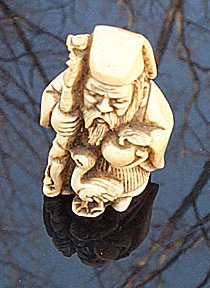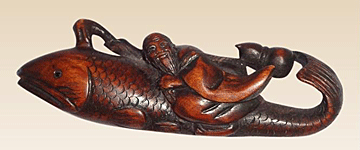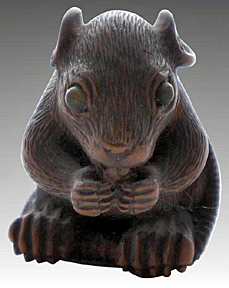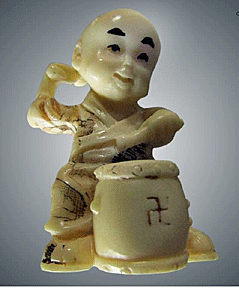|
Little Treasures in the Palm of Your Hand
by Bob Brooke
 Antique
Japanese netsuke (pronounced "netski") have been prized by
collectors since the late 19th century for their beauty and aesthetic
appeal, as well as the legends behind them. With exotic names like
katabon, manju, ryusa, and, they evoke visions of a
far away culture so different from that in the West. Antique
Japanese netsuke (pronounced "netski") have been prized by
collectors since the late 19th century for their beauty and aesthetic
appeal, as well as the legends behind them. With exotic names like
katabon, manju, ryusa, and, they evoke visions of a
far away culture so different from that in the West.
Originally designed as a decorative counterweight to secure a Japanese
manís inro, or small wooden or lacquered purse, netsuke, meaning
ďroot,Ē evolved during Victorian times to become objects of status and a
reflection of the person who wore them. Designed to carry a gentlemanís
personal seal, needed to sign all legal documents, the inro was
eventually divided into sections to hold money, perfume, drugs, and
tobacco. Two strings attached to the netsuke helped secure the inro
around the manís obi or kimono sash.
Sculptors most often carved netsuke from wood or ivory, but as their
popularity and status increased, they made them of richer materials,
such as mother of pearl, porcelain, lacquer, amber, and semi-precious
stones. If a collector finds a netsuke made of two materials, it's
probably from a later period. Ranging in size from one to three inches,
sculptors carved these tiny treasures in a wide variety of forms,
including shells, animals, vegetables, and favorite characters from
Oriental folklore and religion.
 Netsuke
is widely available. You may find them shaped like badgers, known for Netsuke
is widely available. You may find them shaped like badgers, known for
their mischievous pranks, or like carp, the symbol for courage. You may
even discover ones shaped like the baku a mythic, elephant-like
creature believed to eat the nightmares of those who sleep on a piece of
paper bearing its name.
Netsuke carvers worked with general subjects but in an often
lighthearted, humorous way. They made their netsuke originally of wood
to be worn, and eventually discarded after daily use. Carvers also made
sure their netsuke had no sharp edges and balanced them so they hung
correctly on the manís sash. A netsukeís size depended on the weight of
the inro and the proportions of the owner. After the Portuguese
introduced tobacco to Japan, smoking became fashionable for merchants
and a sign of success for men not of the samurai class. They wanted more
ornate netsuke to complement the elegant tobacco paraphernalia they
began to carry.
 Carvers
used the tusks of walrus or narwhal or the teeth of a sperm whale, as
well as woods such as mahogany and ebony, to carve the best netsuke.
They used ivory because it was plentiful. Most of the best netsuke
sculptors at the peak of fancy netsuke lived near where marine ivory was
more plentiful. They began using this material because they knew how to
carve it. Itís not only the subject of each netsuke, rather than the
material used, but the extraordinary workmanship that gives each one its
special artistic appeal. Carvers
used the tusks of walrus or narwhal or the teeth of a sperm whale, as
well as woods such as mahogany and ebony, to carve the best netsuke.
They used ivory because it was plentiful. Most of the best netsuke
sculptors at the peak of fancy netsuke lived near where marine ivory was
more plentiful. They began using this material because they knew how to
carve it. Itís not only the subject of each netsuke, rather than the
material used, but the extraordinary workmanship that gives each one its
special artistic appeal.
Eventually, netsuke represented the fashions, fancies, and fables
of Japanese society. After the reopening of Japan to the West in 1853,
Japanese gentlemen soon took to wearing western style suits with
pockets, and the need for carrying an inro with its accompanying netsuke
quickly disappeared.
 Some
of the best Japanese artists, such as Yamada Hojitsu and Shuzan, carved
netsuke. But itís those who specialized in making them that are
highly desired by collectors, for they combined creative designs with
exquisite finishes. Some
of the best Japanese artists, such as Yamada Hojitsu and Shuzan, carved
netsuke. But itís those who specialized in making them that are
highly desired by collectors, for they combined creative designs with
exquisite finishes.
The value of netsuke depends on the artist, region, material and skill
of the sculptor. North American collectors seem to favor katabori,
or pieces which represent an identifiable object. Netsuke of ivory and
wood from the late 18th or 19th century can sell for as high as $10,000,
with those made of a combination of materials selling for $500 and up.
Before starting to collect netsuke, you should be aware of the many
fakes that poor craftsmen make for the tourist trade.
And these fakes seem to be flourishing since fine netsuke is beginning
to get scarce. Reproductions are showing up in shops and shows. While
the ivory may be genuine, the pieces have been "aged" by boiling in
strong tea. Other forgers smear their copies with dirt or brown stain to
simulate the dust of use.
With netsuke, it pays to be an educated collector. Once youíve
seen an example of fine netsuke, the lack of the great care and skill
used in making many pieces becomes obvious.
<
Back
to More Antique Spotlights
Next Article > |
